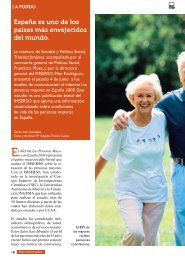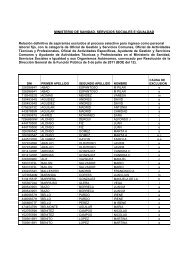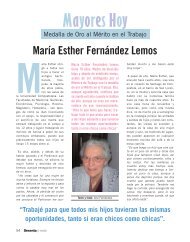Texto Completo de la Publicación (1107 Kb. pdf) - Imserso
Texto Completo de la Publicación (1107 Kb. pdf) - Imserso
Texto Completo de la Publicación (1107 Kb. pdf) - Imserso
- No tags were found...
You also want an ePaper? Increase the reach of your titles
YUMPU automatically turns print PDFs into web optimized ePapers that Google loves.
Tratamientos bien establecidos<br />
TABLA 4.1<br />
Criterios para <strong>la</strong>s Intervenciones Empíricamente Validadas<br />
I. Por lo menos dos estudios <strong>de</strong> comparaciones entre grupos han <strong>de</strong>mostrado <strong>la</strong> eficacia en una o más <strong>de</strong> <strong>la</strong>s<br />
siguientes maneras<br />
A. Superior (estadísticamente significativo) a tratamientos farmacológicos, psicológicamente p<strong>la</strong>cebo u<br />
otros.<br />
B. Equivalente a un tratamiento ya establecido en investigaciones con tamaños muestrales a<strong>de</strong>cuados.<br />
O bien<br />
II. Una amplia serie <strong>de</strong> estudios <strong>de</strong> diseño <strong>de</strong> caso único (n > 9) que hayan <strong>de</strong>mostrado ser eficaces. Estas<br />
intervenciones <strong>de</strong>ben:<br />
A. Utilizar buenos diseños experimentales.<br />
B. Superior (estadísticamente significativo) a tratamientos farmacológicos, psicológicamente p<strong>la</strong>cebo u<br />
otros.<br />
Otros criterios para I y II<br />
III. Los estudios <strong>de</strong>ben ser dirigidos a través <strong>de</strong> manuales <strong>de</strong> intervención.<br />
IV. Las características <strong>de</strong> <strong>la</strong>s muestras <strong>de</strong>ben ser c<strong>la</strong>ramente especificadas.<br />
V. Los efectos <strong>de</strong>ben <strong>de</strong> haberse <strong>de</strong>mostrado por al menos dos investigadores diferentes o equipos <strong>de</strong> investigación<br />
diferentes.<br />
Intervenciones probablemente eficaces<br />
I. Dos estudios <strong>de</strong>ben <strong>de</strong>mostrar que el tratamiento es superior (estadísticamente significativo) a un grupo <strong>de</strong><br />
control en formato lista <strong>de</strong> espera.<br />
O bien<br />
II. Uno o más diseños que cump<strong>la</strong>n los criterios IA, IB, III y IV, pero no V para ser <strong>de</strong>nominados Tratamientos<br />
Bien Establecidos<br />
O bien<br />
III. Una serie <strong>de</strong> estudios <strong>de</strong> diseño <strong>de</strong> caso único escasa (n ≥ 3) y que, a<strong>de</strong>más, cump<strong>la</strong>n los criterios para ser<br />
<strong>de</strong>nominados Tratamientos Bien Establecidos.<br />
4.3. FACTORES QUE LIMITAN LA EFICACIA DE LAS INTERVENCIONES<br />
Por lo tanto, <strong>la</strong>s intervenciones realizadas hasta este momento <strong>de</strong>muestran que <strong>la</strong>s intervenciones pue<strong>de</strong>n<br />
funcionar, pero es necesario examinar cómo mejorar el impacto <strong>de</strong> éstas sobre el malestar <strong>de</strong> los cuidadores.<br />
A continuación se ofrece un análisis más <strong>de</strong>tenido <strong>de</strong> <strong>la</strong>s tres limitaciones seña<strong>la</strong>das.<br />
INTERVENCIONES PSICOEDUCATIVAS CON CUIDADORES DE PERSONAS CON DEMENCIA<br />
75<br />
4.3.1. NECESIDAD DE AJUSTE DE LAS INTERVENCIONES A UN MARCO<br />
TEÓRICO Y EMPÍRICO AMPLIO<br />
Una primera limitación que ha sido repetidamente seña<strong>la</strong>da en re<strong>la</strong>ción a <strong>la</strong> eficacia <strong>de</strong> <strong>la</strong>s intervenciones<br />
hace referencia a <strong>la</strong> necesidad <strong>de</strong> contar con mo<strong>de</strong>los teóricos que faciliten tanto <strong>la</strong> explicación

















